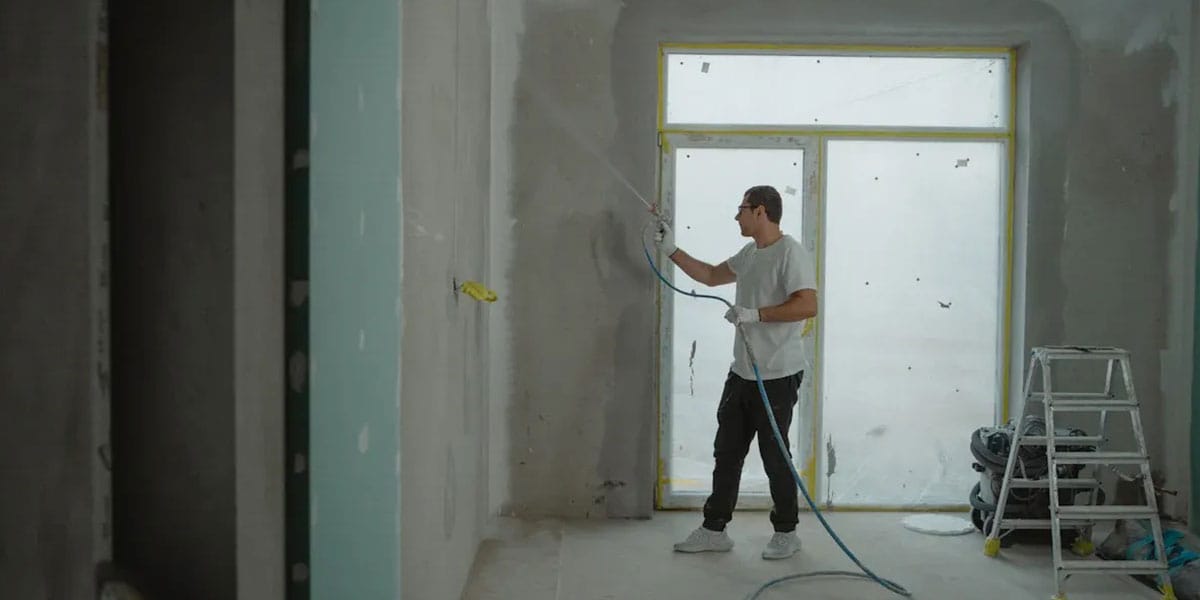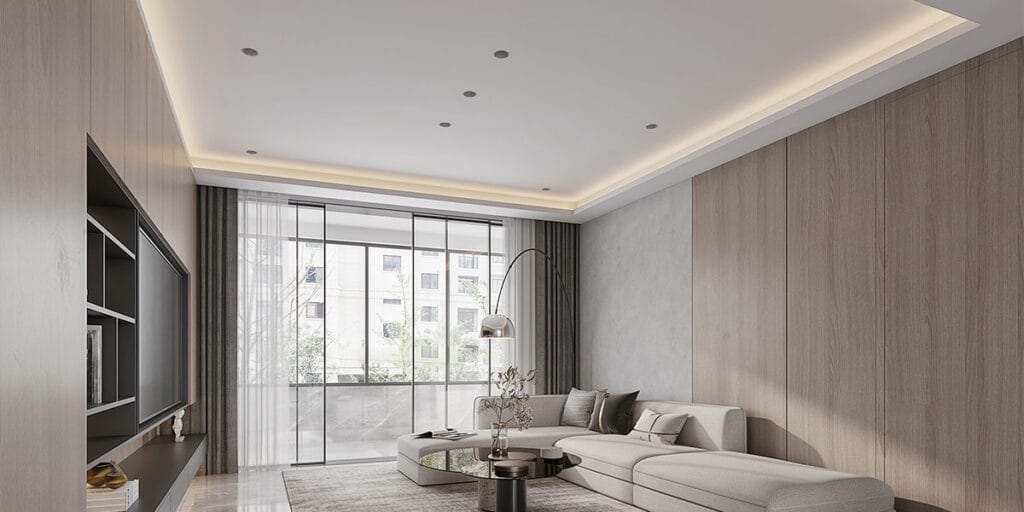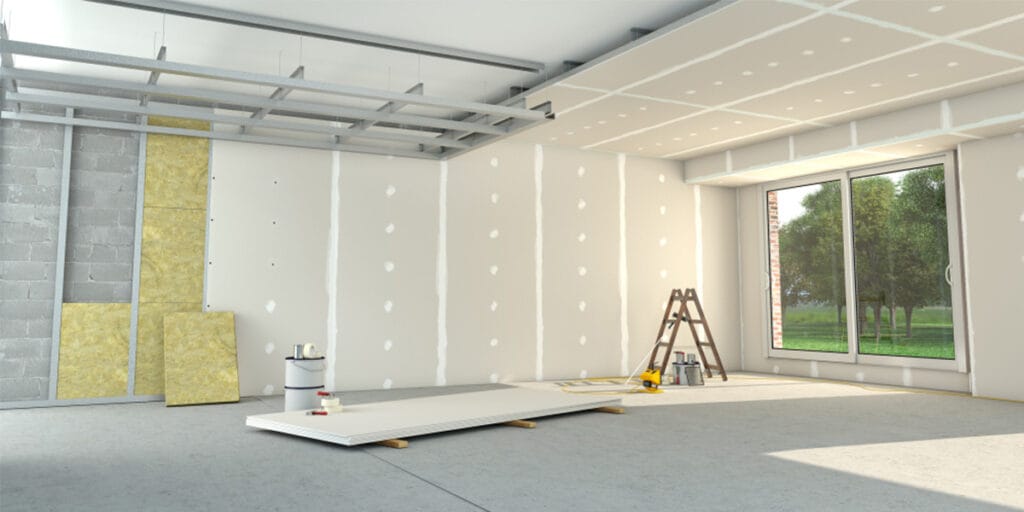
21 Apr MgO Board Drywall vs Cement Board Drywall
Table of Contents
Comparing Mgo Board and Cement Board Drywall
Explore the key differences between Mgo and cement board drywall.
Features | mgo board drywall | cement board drywall |
|---|---|---|
Durability | Very strong, handles impacts well. | Strong but may crack over time. |
Fire Resistance | Excellent, withstands high heat. | Good, but less effective than MgO. |
Moisture Resistance | Great at preventing mold damage. | Good, but absorbs water over time. |
Cost | Higher upfront cost, lasts longer. | Cheaper initially, more maintenance needed. |
Eco-Friendliness | Made from natural, recyclable materials. | Less eco-friendly, uses more chemicals. |
Installation Ease | Lightweight, easy to cut and install. | Heavier, requires special tools. |
Best Uses | Ideal for fire-rated and wet areas. | Good for basic tile backing and outdoor use. |
When picking between mgo board drywall and cement board drywall, knowing their differences helps you choose better. These materials are compared because they are strong, resist fire, and handle moisture well. For instance, mgo board drywall is better at resisting water and is eco-friendly. Cement boards, however, are cheaper and good at resisting fire. Both are important in building today, but their strengths fit different uses.
Key Takeaways
MgO board drywall is great at stopping fire. It lasts up to 4 hours in high heat, making it safe for important projects.
In wet places like bathrooms and kitchens, MgO board drywall works better. It resists water and stops mold from growing.
MgO boards cost more at first but save money later. They last long and need less fixing.
Cement board drywall costs less and works for simple projects. But it might need extra sealing to keep out water.
Pick MgO board drywall for green building projects. It’s made from natural stuff and can be recycled.
Durability
Strength and Longevity
Both mgo board drywall and cement board drywall are strong, but they differ. MgO boards are very tough. They can handle heavy weight and impacts without breaking. This makes them great for areas needing long-lasting strength. Cement boards are strong too but may crack under heavy pressure over time.
Feature | MgO Boards | Fiber Cement Boards |
|---|---|---|
Very strong, handles impacts, supports heavy loads. | Strong but may crack under heavy pressure. | |
Fire Resistance | Excellent at resisting fire and high heat. | Fire-resistant but not as good as MgO boards. |
Moisture Resistance | Great at stopping mold and water damage. | Good with moisture but absorbs water over time. |
Cost | Costs more upfront but lasts longer. | Cheaper at first but needs more upkeep. |
This table shows why mgo board drywall is better for strength and lasting use. It handles wear and tear well, making it a top choice for tough jobs.
Resistance to Cracking and Impact
Cracking and impact resistance are important for building materials. MgO boards are great here. They can take hits without breaking, which is helpful in busy areas or places with lots of movement. Cement boards are strong but can crack under heavy impacts or vibrations over time.
If you need something that stays strong and doesn’t break easily, mgo board drywall is the better pick. It lasts longer and needs fewer repairs, saving you money and effort.
Fire Resistance
Fireproof Properties of Mgo Board Drywall
Mgo board drywall is great at resisting fire. It doesn’t burn and stays strong in high heat. Tests like ASTM E119 and EN 13501-1 prove it works well in fires. For example, mgo boards can handle fire for 1 to 4 hours. This makes them a safe choice for places where fire safety matters.
The ASTM E119 test heats mgo boards to over 1600°F. Even then, they stay strong and stop fire from spreading. This makes them perfect for schools, offices, and other buildings needing fire protection.
Fireproof Properties of Cement Board Drywall
Cement board drywall also resists fire very well. Like mgo boards, it doesn’t burn and works in hot areas. It’s often used in kitchens and utility rooms where fire safety is needed.
Cement boards have fiberglass, which helps them resist fire better. They are common in apartments and business buildings because they are dependable. But they might not last as long as mgo boards in extreme fires.
Comparison of Fire Resistance
Both materials are good at resisting fire but suit different needs.
Mgo board drywall:
Handles fire for up to 4 hours.
Stays strong even in high heat.
Tested by strict standards like ASTM E119 and EN 13501-1.
Cement board drywall:
Resists fire well but may not last as long as mgo boards in tough conditions.
Fiberglass adds extra fire protection.
Feature | MgO Boards | Cement Boards |
|---|---|---|
Fire Resistance | Doesn’t burn; handles heat for up to 4 hours. | Doesn’t burn; good fire resistance. |
Structural Integrity | Stays strong during fire exposure. | Strong but not as durable as mgo boards in extreme fires. |
If fire safety is most important, mgo board drywall is the better choice because it lasts longer and works reliably.
Moisture Resistance
Water Resistance of Mgo Board Drywall
Mgo board drywall is great at keeping water out. Unlike regular drywall, it doesn’t soak up water. This helps it stay strong even in wet places. It’s a smart pick for bathrooms, kitchens, and basements. Its special material stops water from getting inside, so it won’t swell or bend.
Mgo boards also stop mold and mildew from growing. This is very important in damp areas. They can handle high humidity, making them last a long time. These features make mgo board drywall a dependable choice for wet spaces.
Water Resistance of Cement Board Drywall
Cement board drywall works well in wet areas too. It’s often used under tiles in kitchens and bathrooms because it resists water. But, unlike mgo boards, it can soak up some water over time. This might cause it to swell or weaken if not sealed properly.
To work better in wet places, cement boards need extra waterproof layers. While they do resist water, they might not last as long as mgo boards in very humid spots.
Mold and Mildew Resistance
Both mgo board drywall and cement board drywall fight mold and mildew, but one is better. Mgo boards are the best because their material doesn’t let mold grow. This keeps indoor spaces healthier, especially in damp rooms like bathrooms.
Cement boards also resist mold but not as well as mgo boards in wet conditions. Tests like ASTM G 21 and ASTM D 3273 show that some materials, like National Gypsum‘s XP Gypsum Board, score high for mold resistance. Still, mgo boards are the top choice for long-lasting protection.
Drywall Material | ASTM G 21 Score | ASTM D 3273 Score |
|---|---|---|
National Gypsum’s XP Gypsum Board | 0 | 10 |
ProForm® Lite Blue™ with Dust-Tech® | Not specified | Better than standard compounds |
If you want the best mold and mildew protection, mgo board drywall is the way to go. It lasts longer and keeps your space healthier.
Eco-Friendliness

Environmental Impact of Mgo Board Drywall
Mgo board drywall is very eco-friendly. It uses natural, safe materials without harmful chemicals or VOCs. Making these boards needs less energy, which lowers pollution. They can be fully recycled, cutting down on waste and helping the environment.
Attribute | Description |
|---|---|
Natural Composition | Made from safe, natural materials |
Low Energy Consumption | Uses less energy to produce |
Recyclability | Can be recycled and reused |
Resistance to Harmful Substances | Free from asbestos and other dangerous materials |
Emission of Harmful Chemicals | No harmful chemicals or VOCs released during production |
Longevity | Lasts long, so fewer replacements are needed |
Environmental Impact | Doesn’t harm forests like wood products |
These features make mgo board drywall a great choice for green building projects.
Environmental Impact of Cement Board Drywall
Cement board drywall also helps the environment in some ways. Factories save energy, cutting pollution by 20,000 metric tons each year. They recycle water during production and use recycled materials in the boards. Lightweight designs also lower fuel use during shipping.
Evidence Type | Details |
|---|---|
Energy Savings | Saved $3 million yearly since 2004 by using less energy. |
Greenhouse Gas Emissions Reduction | Cuts 20,000 metric tons of pollution yearly compared to coal power. |
Recycling Water | Reuses water during manufacturing. |
Recycled Content | Uses recycled paper for board faces and backs. |
Byproduct Gypsum Usage | Some plants use gypsum from coal plant emissions. |
Weight Reduction | Lighter boards need less fuel for transport. |
These efforts show how cement board drywall reduces its environmental impact.
Comparison of Eco-Friendliness
When comparing both, mgo board drywall is greener. Its natural materials and recyclability make it better for the planet. Cement boards, while helpful, use more energy and chemicals to make.
Feature | MgO Boards | Gypsum Boards |
|---|---|---|
Eco-Friendliness | Made from natural, recyclable materials | Less eco-friendly; uses chemical additives |
Mgo boards are the best choice for cutting waste and pollution. If you care about the environment, pick mgo board drywall.
Cost
Material Costs
When looking at costs, MgO board drywall and cement board drywall differ a lot. MgO boards cost more at first because they are made with advanced materials and perform better in strength and water resistance. Cement boards, however, are cheaper upfront, making them a good pick for tight budgets.
Here’s a simple comparison:
MgO Board Drywall: Costs more now but saves money later.
Cement Board Drywall: Cheaper to buy but needs more upkeep.
If your project needs something strong and long-lasting, MgO boards are worth the extra cost.
Installation Costs
The cost to install depends on the material. MgO boards are light and easy to work with, which can lower labor costs. Cement boards are heavier and take more time to install, but they are still manageable.
Material | Cost per square foot (SF) | |
|---|---|---|
Traditional Drywall | $6 | ~$0.18 |
Wood Lattice | $14 | ~$0.48 |
Even though the table shows costs for other materials, MgO boards are often worth their price because they are easier to handle and quicker to install.
Long-Term Value
For long-term value, MgO boards are the best choice. They last longer and resist fire, water, and mold, so you won’t need as many repairs. Studies show MgO boards save money over time. Cement boards are good too, but they might crack or absorb water, leading to higher maintenance costs.
If you want a material that performs well and saves money over time, MgO board drywall is the smarter option. It lasts longer and needs less care, making it great for eco-friendly building projects.
Ease of Installation
Installation Process for Mgo Board Drywall
Putting up MgO board drywall is simple and like regular drywall. You can cut it with a utility knife or use tools like saws and drills. Attaching it to frames or studs is easy with screws or nails. The boards can bend slightly, making them great for curved designs or creative projects.
MgO boards work well indoors and outdoors. They don’t soak up much water, so they stay strong even in damp places. To finish, treat the joints like normal drywall by using joint compound and mesh tape. This gives a smooth and neat look.
Feature | Description |
|---|---|
Applications | Fire walls, partitions, shower tile backers, structural sheathing. |
Cut, snap, drill, and fasten like regular drywall. | |
Flexibility | Bends for curves; more flexible than cement boards. |
Joint Treatment | Uses joint compound and mesh tape for finishing. |
Installation Process for Cement Board Drywall
Installing cement board drywall takes more effort because it’s heavier. Cutting it needs a carbide-tipped tool or a power saw with a diamond blade. This creates dust, so wearing safety gear is important. Use corrosion-resistant screws to attach it to frames, ensuring it lasts in wet areas.
For joints, edges need to be beveled or rabbetted for tape and mud. Non-shrinking caulk can also help create a smooth finish. Let the boards adjust to the room’s conditions before installing to avoid cracking later. This step helps prevent movement-related problems.
Aspect | Details |
|---|---|
Joint Filling Methods | Bevel edges for tape and mud; use non-shrinking caulk. |
Use 8mm+ for ceilings, 10mm+ for walls, 12mm+ for fire resistance. | |
Mitigating Cracking | Let boards adjust before installing; isolate joints to avoid cracks. |
Comparison of Installation
MgO board drywall is easier and quicker to install. It’s lightweight and simple to cut, saving time and effort. Basic tools are enough, making it good for DIY or professional projects. Its flexibility also allows for creative designs.
Cement board drywall is tougher to install. It needs special tools and more preparation. Its weight makes handling harder, and extra steps like acclimatization add time.
If you want fast and easy installation, MgO board drywall is the best choice. But for areas needing extra strength in wet or high-impact spaces, cement board drywall might be worth the extra work.
Best Uses for Each Material

When to Use Mgo Board Drywall
Pick mgo board drywall for projects needing strength, fire safety, and water protection. It can handle heat up to 1200°C, making it great for fire-rated walls in schools, hospitals, and offices. In wet places like bathrooms, basements, or pool areas, it stops mold and mildew, lasting longer.
It’s also good at blocking noise. For quiet spaces like offices or studios, its material absorbs sound well. Plus, it’s eco-friendly, so it’s perfect for green building projects. If you’re building a sustainable home or a LEED-certified structure, mgo board drywall fits your environmental goals.
Feature | Performance |
|---|---|
Fire Resistance | Handles heat up to 1200°C |
Moisture Resistance | Stops mold and mildew in damp areas |
Strength and Integrity | Holds heavy loads, up to 14 MPa |
Noise Resistance | Great at reducing sound |
Eco-friendliness | Made from natural, green materials |
When to Use Cement Board Drywall
Choose cement board drywall for projects where cost and basic durability matter. It’s often used under tiles in kitchens and bathrooms because it resists water. While it can absorb some moisture, adding a waterproof layer improves its performance.
For outdoor use, cement boards work well. When sealed, they handle weather exposure, making them good for exterior walls or siding. They’re also fire-resistant, so they’re useful in garages or utility rooms.
If you need a budget-friendly option for simple jobs, cement board drywall is a solid pick. It’s versatile and balances cost with function.
Side-by-Side Comparison
Feature | Mgo Board Drywall | Cement Board Drywall |
|---|---|---|
Fire Resistance | Handles extreme heat, up to 1200°C | Fire-resistant but less strong in high heat |
Moisture Resistance | Excellent; stops mold and mildew | Good; needs sealing for better results |
Strength and Durability | Very strong; holds heavy loads | Strong but may crack over time |
Eco-friendliness | Made from natural, recyclable materials | Uses recycled parts but less eco-friendly |
Best Applications | Fire-rated walls, wet areas, soundproofing | Tile backers, outdoor walls, utility rooms |
Tip: For top performance in fire, water, and sound resistance, go with mgo board drywall. For simpler, cost-effective projects, cement board drywall is a good choice.
When looking at MgO board drywall and cement board drywall, they perform differently. MgO boards are great for fire safety, water resistance, and being eco-friendly. They last a long time, making them perfect for tough jobs. Cement boards are cheaper and work well for simple projects, like tiled spaces or outdoor areas.
If you need fire protection or care about the environment, choose MgO board drywall. For affordable projects needing decent strength, cement board drywall is a good option. Pick based on what your project needs most.
FAQ
What makes MgO board drywall different from cement board drywall?
MgO board drywall is better at stopping fire, water, and mold. It’s also eco-friendly. Cement board drywall costs less and is good for simple jobs like tile backing or outdoor walls. Pick based on what your project needs.
Which is best for wet places like bathrooms?
MgO board drywall works best in wet areas. It blocks water, mold, and mildew without extra sealing. Cement board drywall can handle damp spots but needs waterproof layers to last longer.
Are both easy to install?
MgO board drywall is lighter and simpler to cut, so it’s faster to install. Cement board drywall is heavier and needs special tools, which takes more time. For quick and easy work, MgO boards are better.
Which one is more eco-friendly?
MgO board drywall is the greener choice. It’s made from natural materials, uses less energy to make, and can be recycled. Cement board drywall uses recycled parts but needs more energy to produce.
Can MgO board drywall help with soundproofing?
Yes, MgO board drywall is great at reducing noise. It’s perfect for quiet spaces like offices or studios. Cement board drywall helps a little with soundproofing but isn’t as good as MgO boards.
